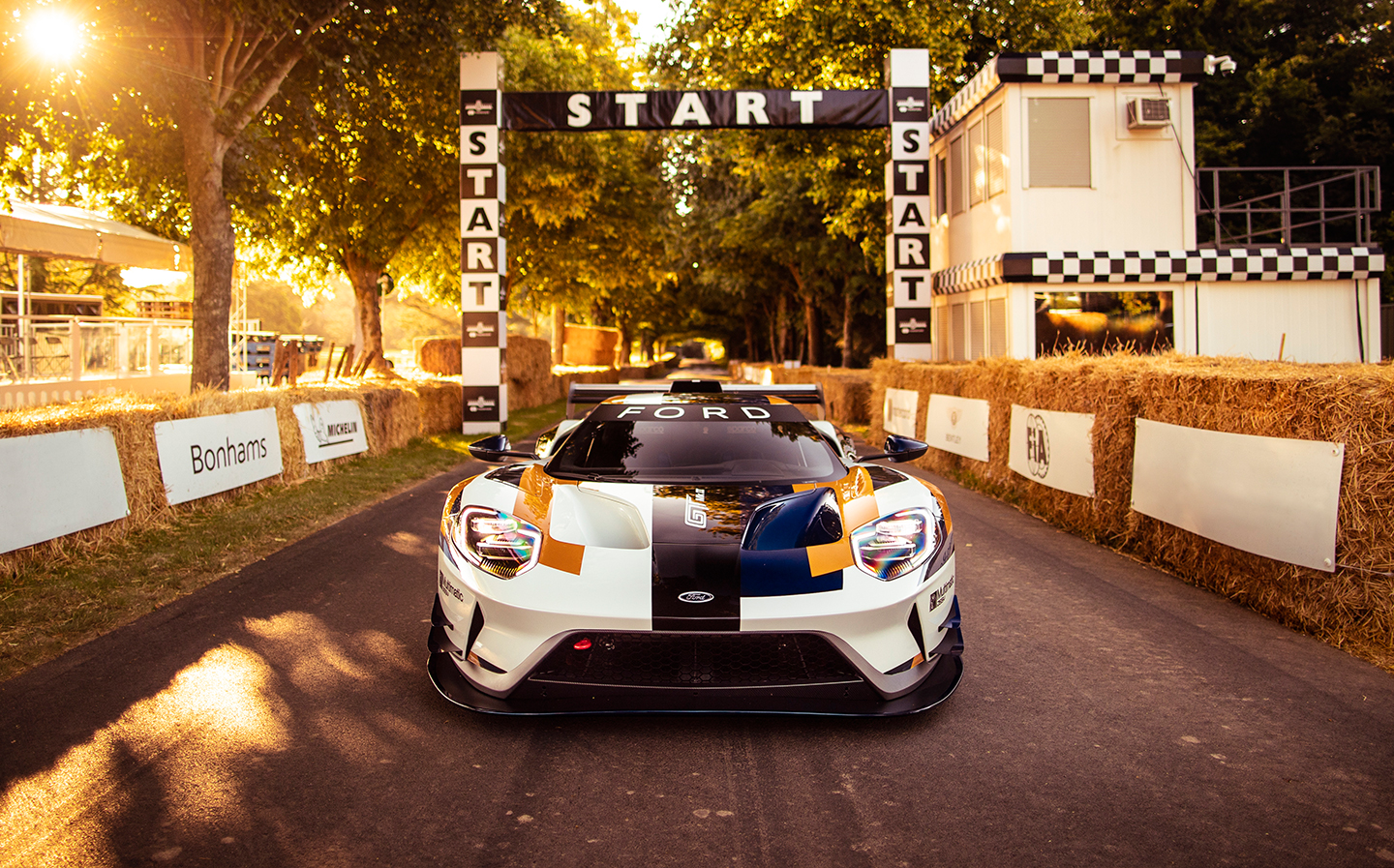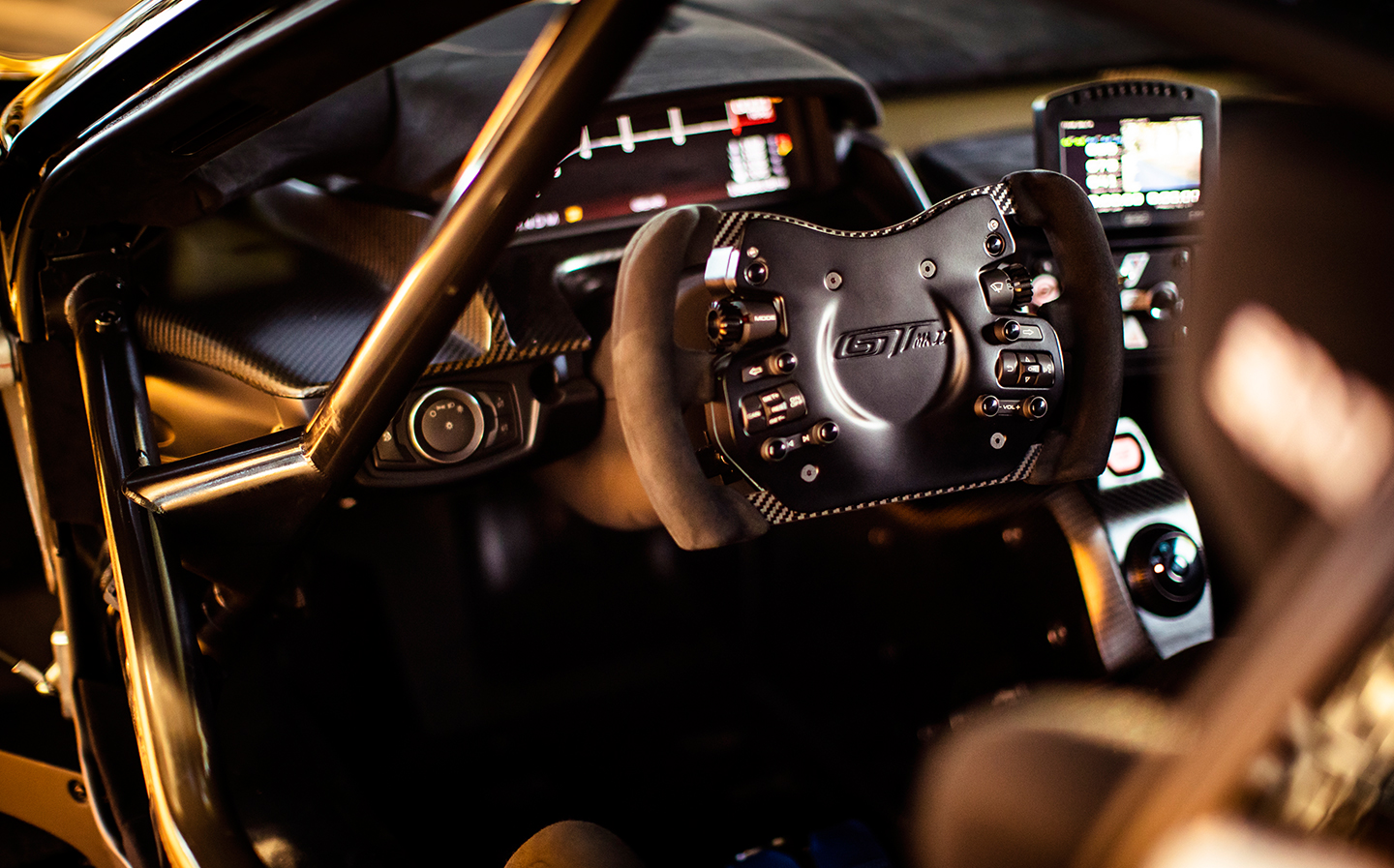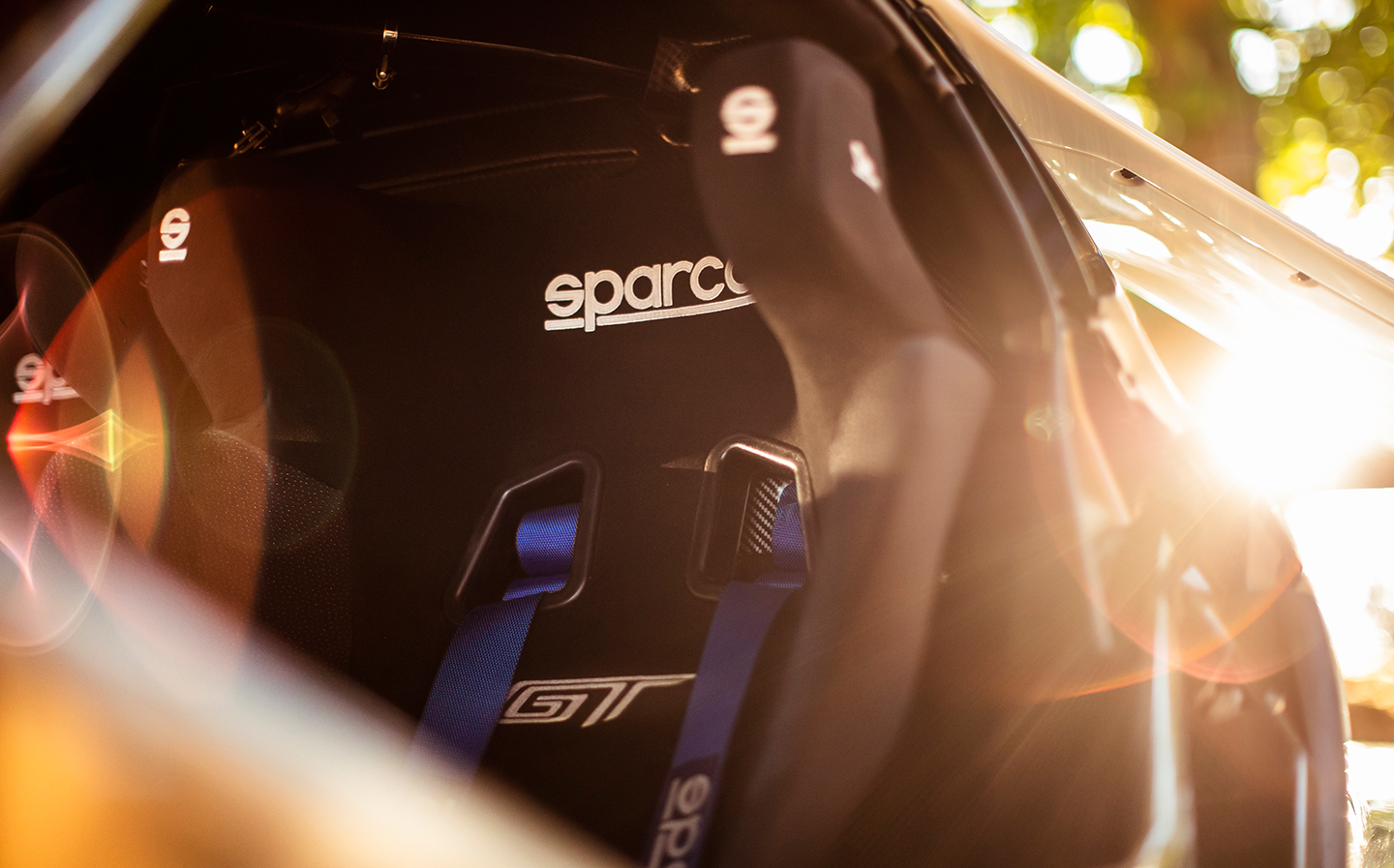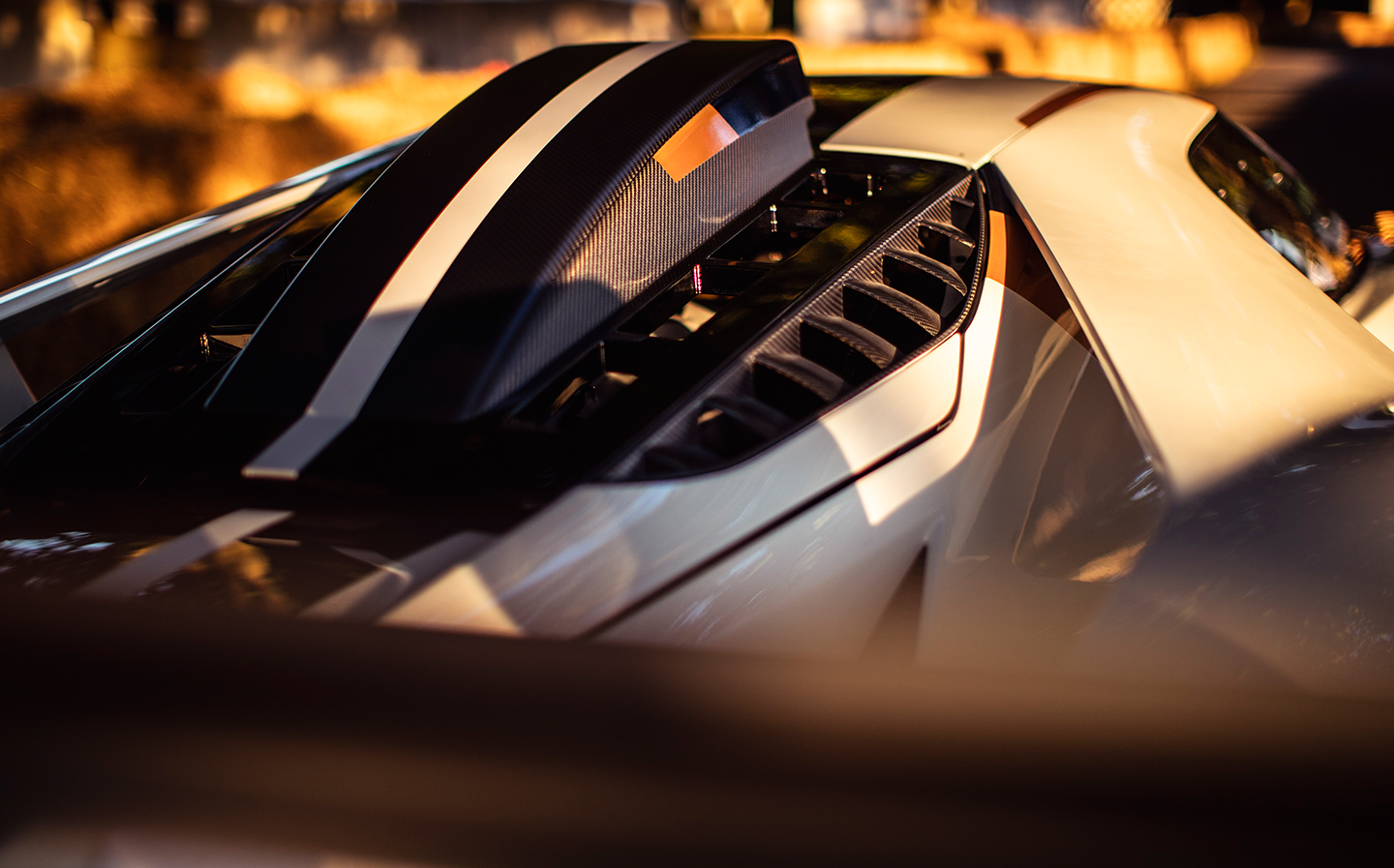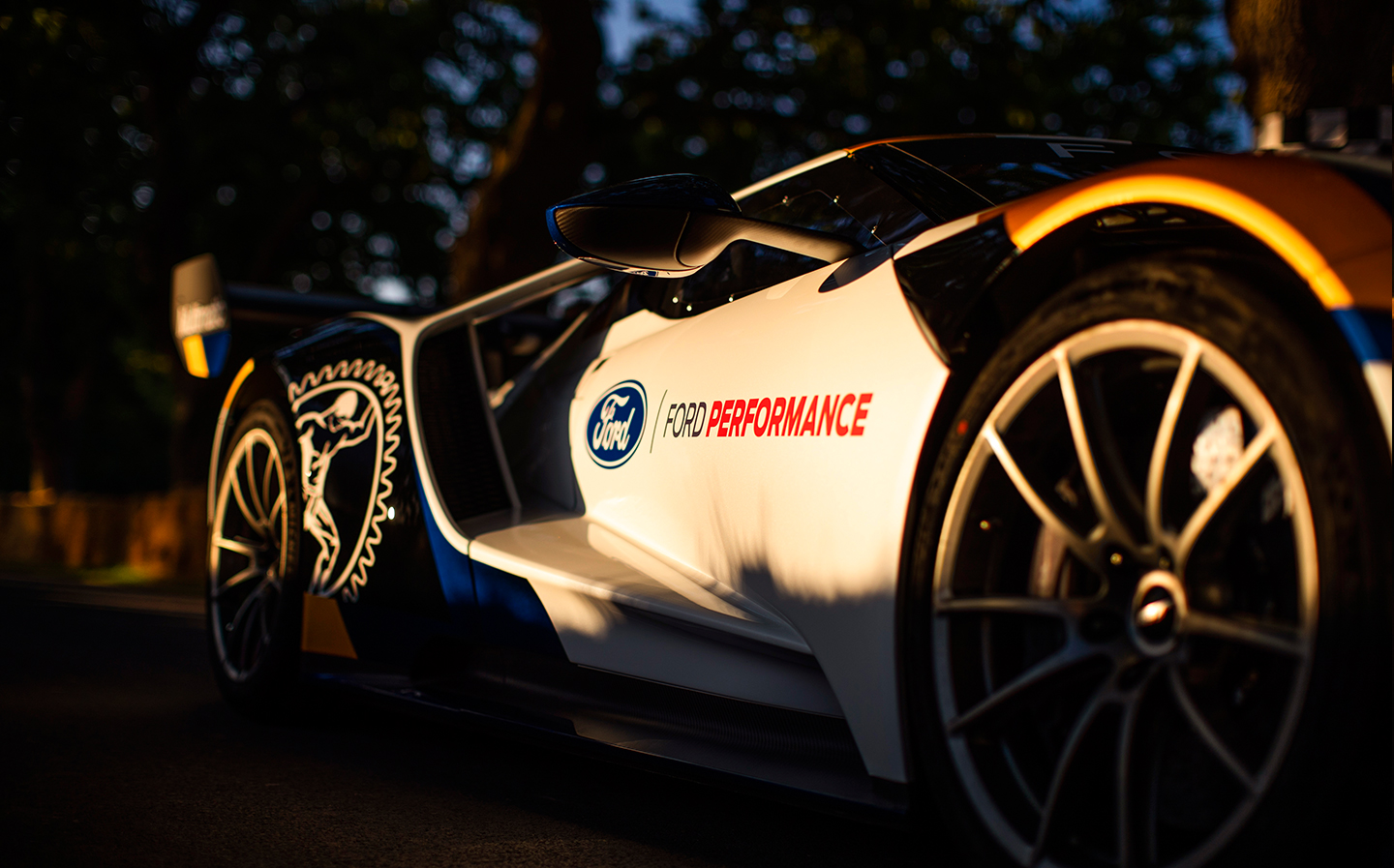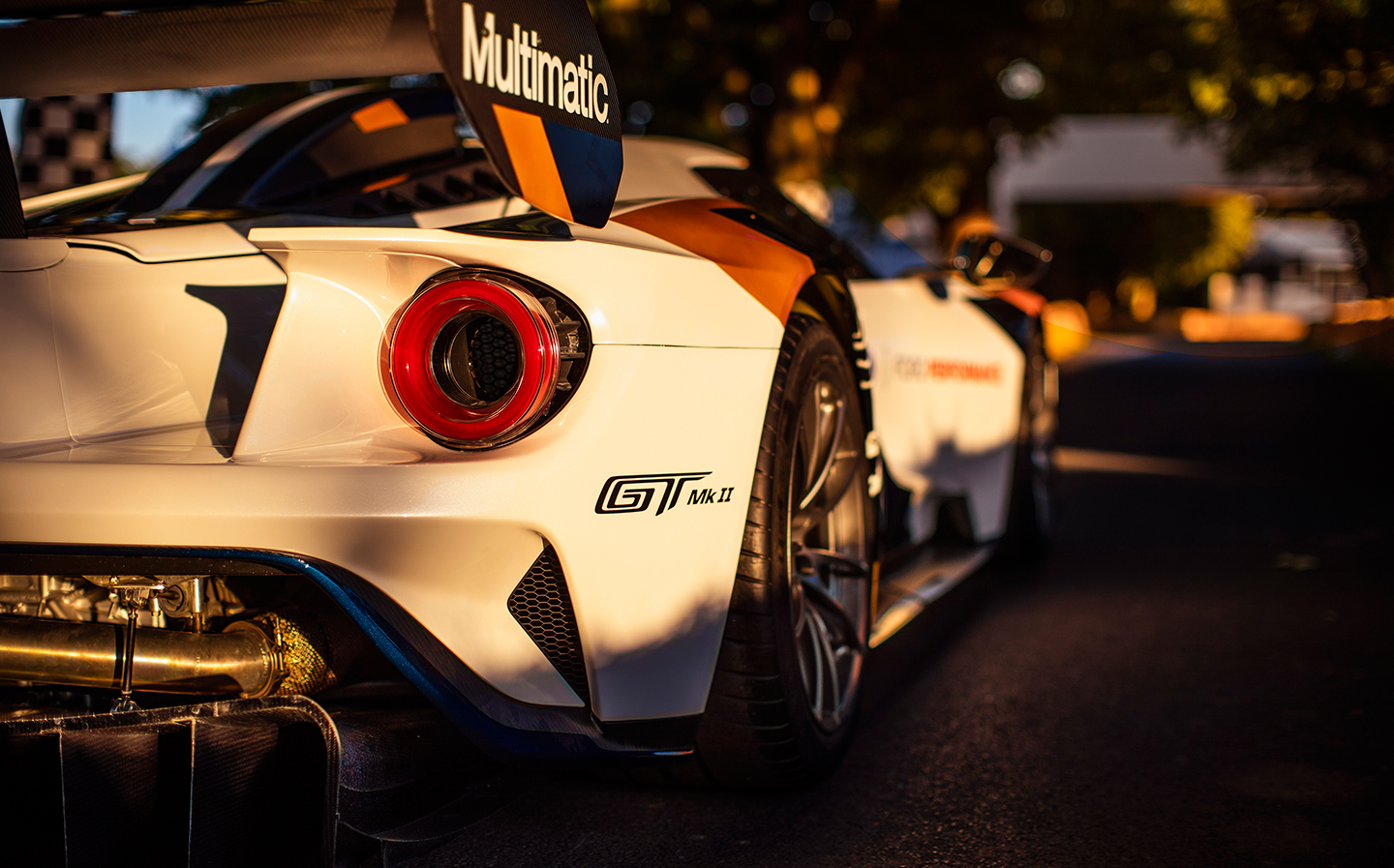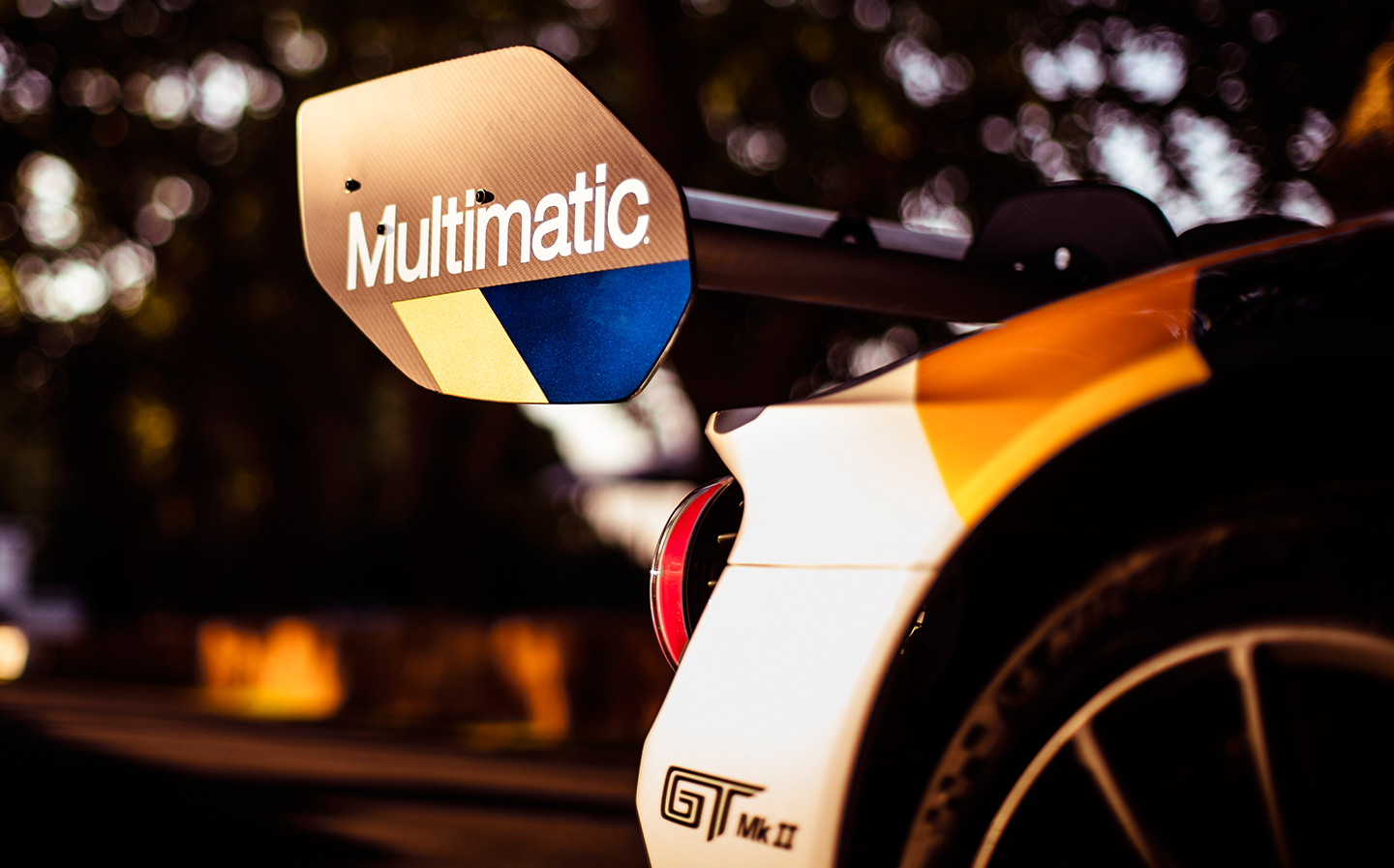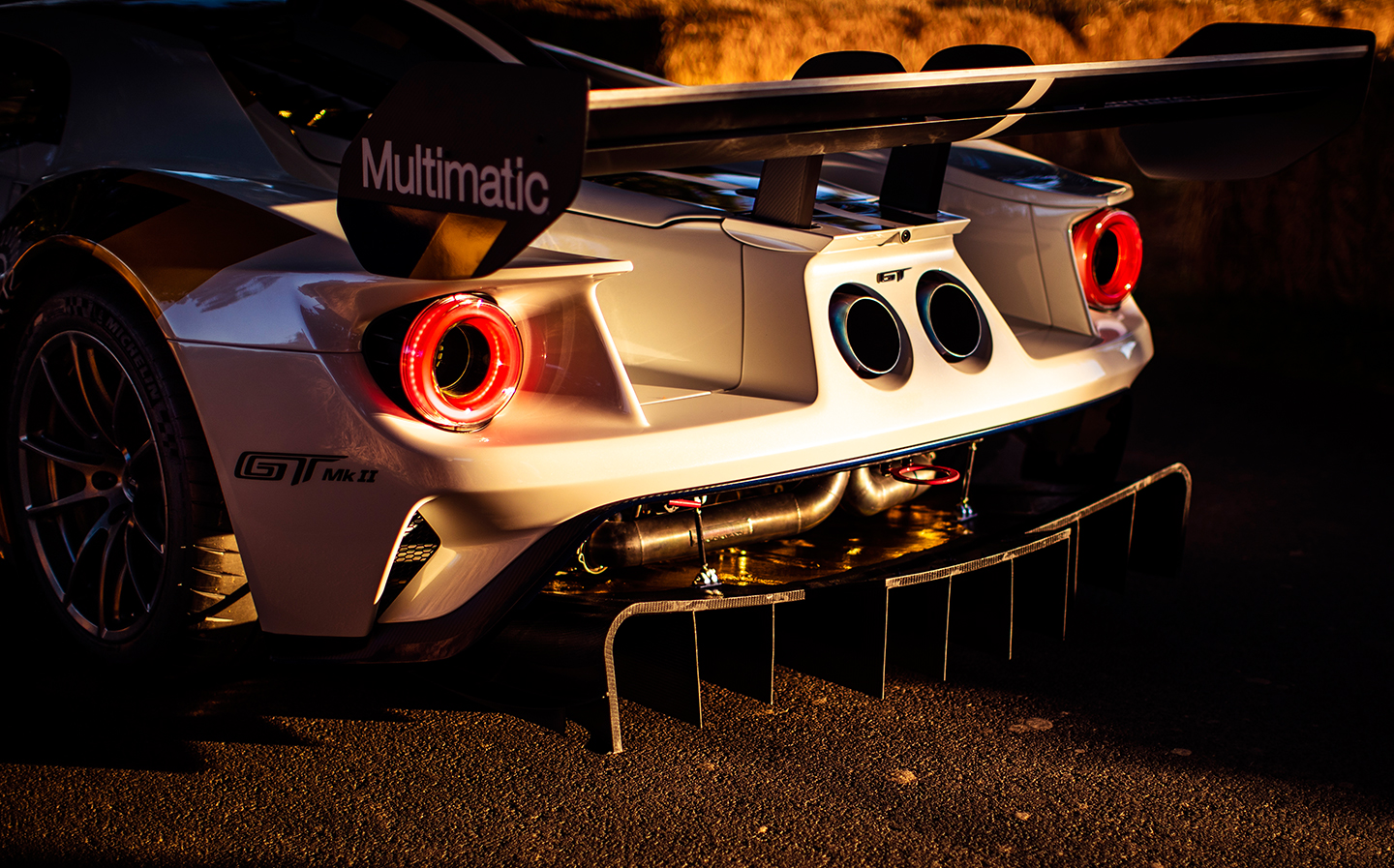Too quick for Le Mans: we buckle up in wild Ford GT Mk II for Goodwood ride (video)
The GT's true potential 'unleashed' at FoS
THE FORD GT is a quick car by any standard. It was created specifically to win at the 2016 Le Mans 24 Hours (in the GTE Pro class) on the 50th anniversary of its legendary victory over Ferrari at the race in 1966, and although the street version was developed in parallel, by the same team, it actually came out a year after Ford’s (successful) Le Mans bid. That means the GT is a racing car that was then sanitised for the road.
The 1,350 examples that are being fitted with registration plates boast 647bhp from their 3.5-litre twin-turbo V6 EcoBoost engines, which is good for 0-60mph in “sub-3 seconds” and a top speed of 216mph. Thats’s actually more potent than the racing version, which suffers from that fact that the World Endurance Championship (WEC) regulations limit competitors’ power to just a shade above 500bhp.
What’s more, for Le Mans there’s a minimum weight limit of 1,245kg and further “balance of performance” measures to ensure the cars run closely together in the race. Ford took the GTE Pro class’s biggest hit in terms of ballast at Le Mans this year, its cars having to run 12kg heavier than they did in 2018. In other words, it has to race with one arm tied behind its back.
Of course, that doesn’t mean the road car walks all over the WEC version around a track. The racer’s V6 power deficit aside, its fixed rear wing and race-spec aero parts generate more downforce than the road car’s fancy bodywork and active rear wing can muster. The brakes and tyres differ, too.
In addition, the bespoke racing suspension is fixed in the race car whereas the road car has a Jeckyll and Hyde dual-purpose set-up — one set of springs for road use, one set for circuit use. Switch to Track mode and the former set is locked out and the car drops 50mm onto its race suspension.
How do the two compare on track? A twin test by Car Magazine saw the race car lap the Motorland Aragón circuit in Spain 10 seconds quicker than the road car, despite the circa 150bhp power deficit. Of course, it’s not really a fair fight, particularly as the GTE car was riding on slick tyres (although, according to the writer, they were cold when the lap time was set).
Enter the Ford GT Mk II
But what if the Ford GT was not restricted by regulations for either the road or the World Endurance Championship? Just how fast could it go without clipped wings? What is its maximum potential?
That’s the question answered by the GT Mk II. Ford Performance and Multimatic, the automotive parts supplier that collaborated on the development of the GT, created the limited-edition, track-only Mk II to “unleash the full performance potential” of the car.
Multimatic assembles the GT Mk II at it HQ in Markham, Ontario, alongside the road car, using bespoke aero parts and components that have proven themselves on the race track.
The fixed rear wing on the Mk II is even bigger than the one on the GTE Pro car, split level and with larger endplates. The front splitter, too, is more sizeable than that of the race car, protruding noticeably from the under the nose. It works with the diffuser and new fender louvres and dive planes (come on, you do know what those are) to add ground effect and help balance out the extra grip at the rear.
Racing car in front, Ford GT Mk II behind. It’s a sensational thing. And all you need is $1.2m. #FOS #Goodwood #GoodwoodFoS pic.twitter.com/izldJRSPwO
— Will Dron (@wdron) July 4, 2019
The result is four times more downforce than the road car can muster and, given the no-holds-barred engineering, no doubt more than even the Le Mans car can manage.
The fixed aero elements, along with racing suspension (including 5-way adjustable Multimatic dampers) and 19in Michelin Pilot Sport GT slick tyres, enable the Mk II to pull more than 2g of lateral grip, meaning it can stick to the asphalt even when the a force equal to double the car’s weight is trying to push it away from the inside of a corner.
And speaking of weight, the GT Mk II is 90kg lighter than the standard Ford GT, which has a dry weight of 1,385kg. Removing the fancy two-tier suspension helped, as did stripping out the different drive modes.
One other thing mercilessly ripped from the GT Mk II is the air conditioning system, the result of which in the searing heat at the 2019 Goodwood Festival of Speed was an interior hotter than the surface of the Sun (read on for the passenger ride experience). Even the race car has air conditioning — that’s a requirement of the Automobile Club de L’Ouest, which governs the Le Mans 24-Hour race; GTE Pro cars are fitted with a thermometer to monitor the cabin temperatures during the race.
As there are no rules restricting the GT Mk II, Ford and Multimatic ditched the cooling system, which not only reduces weight but also ensures no horses are drained from the engine.
And I thought riding in the Radical was hot… the Ford GT Mk II is another level. Interesting fact: LM GTE Pro regs require air con, so the race cabin is cooled while the GT Mk II’s is not. ?? This man, @smaxwell27, is always super cool, though. Awesome ride. Thanks! pic.twitter.com/mgKht1OCn1
— Will Dron (@wdron) July 4, 2019
Keeping the engine, seven-speed gearbox and dual-clutch transmission (taken from the road car but re-mapped for track use) cool was deemed essential, however; now tuned to produce and handle “700-plus horsepower” (more than 690bhp), the powertrain needs not only the overgrown roof-mounted air scoop but also a “high capacity air-to-air outboard mounted charge air cooler with water spray technology”. This activates when the temperature rises to ensure a consistent level of power.
Stopping power comes from the road car’s power-assisted carbon ceramic Brembo discs (15.5in at the front, 14.1in at the rear), which are, evidently, quite good enough for hammering around a track.
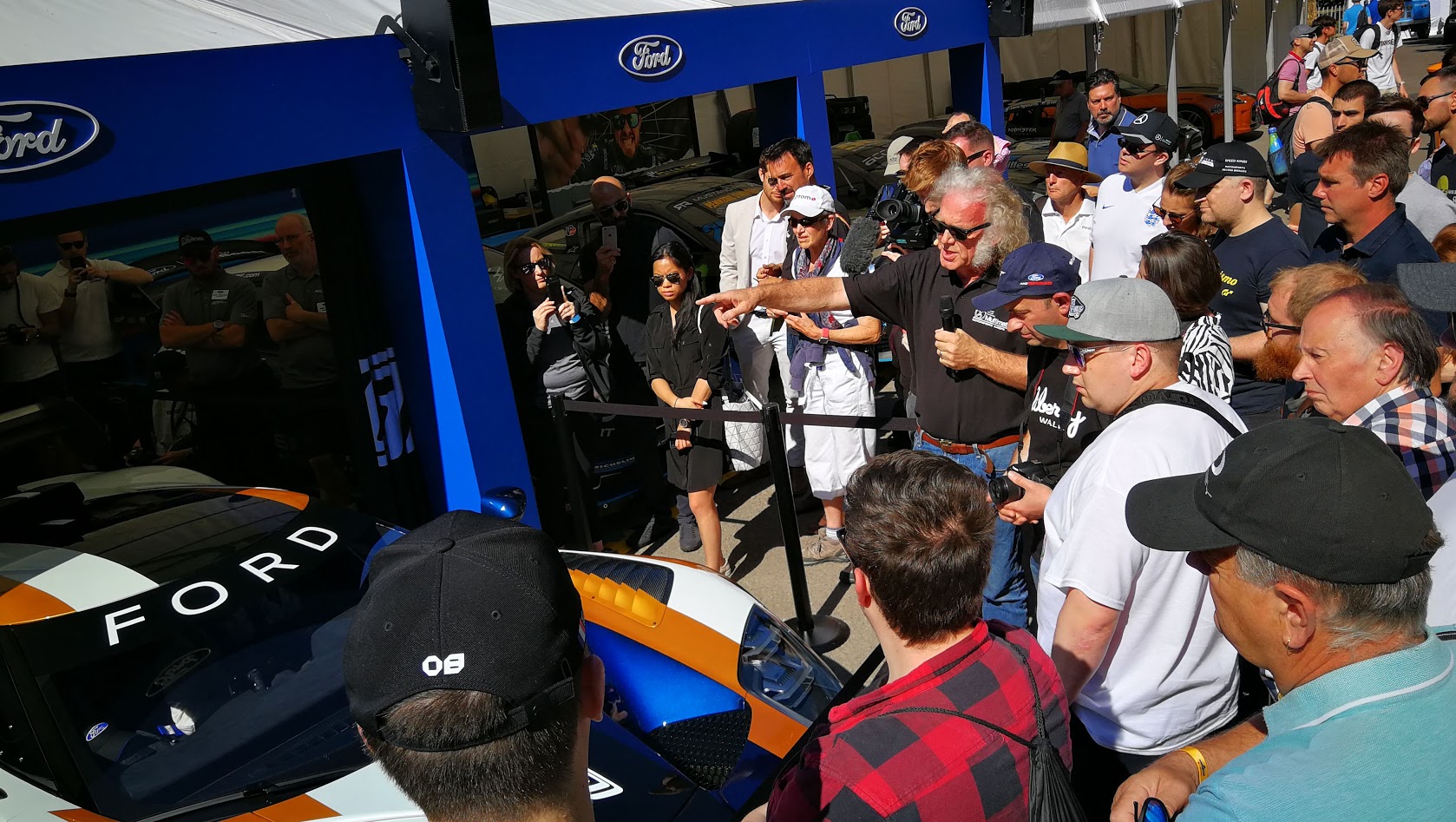
The changes result in lap times 10 seconds quicker than those of the road car, claims Larry Holt, Multimatic’s big-haired chief technical officer (holding the mic, above). Which would make the Mk II the closest thing mere mortals will get to driving the Le Mans versions.
Mind you, these mortals will need to have wealth of Plutus: the asking price is $1.2m (£960,000) — more than twice the cost of the road car. You’ll need to buy a trailer to get it to and from the track, too.
Assuming you have that kind of cash, scarcity may be more of an issue; just 45 examples are being constructed. If you’re not already on the list, you’re probably out of luck.
Meeting the Ford GT Mk II
At Goodwood Festival of Speed, cars are sent up the hill in batches. At the 2019 event earlier this month, the GT Mk II was in “Batch 6 – Supercars, Road Bikes and First Glance”, which contained some of the most exotic new machinery in the world. Highlights included the W Motors Fenyr Supersport, Apollo IE, Dallara Stradale, De Tomaso P72 and Brabham BT62, along with some of the most exclusive Ferraris, Lamborghinis and McLarens.
And yet the Ford GT Mk II seemed to have top billing on the Thursday of the event, following its unveiling earlier that morning. I found it prior to the passenger ride not in the main assembly area but beyond the barriers in its own little holding area, away from even the VIPs lucky enough to experience the cars listed above.
The Mk II is an extraordinary-looking thing that seems to sit impossibly low to the ground, an effect exaggerated by the fact that it was parked on grass, rather than Tarmac, by the side of the filter road. I slipped my hand underneath the carbon floorpan to feel the gap. “Fifty-six millimetres,” one of the Multimatic crew told me before I had the chance to ask, though I suspect it’s even less than that in places.
Who needs ground clearance, eh? The #FordGTMkII doesn’t have suspension that drops in Track Mode, like the road-going model – this is it, folks. Multimatic says 56mm to the asphalt but it looks less than that in places. #FOS pic.twitter.com/IpyF6LrSpz
— Will Dron (@wdron) July 5, 2019
The low overall height of the Mk II, combined with the flying-buttress rear bodywork that’s shrink-wrapped around the V6 powerplant, make the split-level rear wing look simply enormous. And of course you can’t miss the scissor doors, rising up like an eagle’s wings stretching before a hunt.
Scott Maxwell, Ford’s driver at Goodwood, greeted me with an effusive hello. He was one of the the Mk II’s lead development drivers, based in Canada, but has been dividing his time between his home country and the UK, where he’s been competing in the 2019 British GT Championship.
A charming and engaging man, it’s obvious he also takes his work very seriously as he segued seamlessly between chit-chat with me and shop talk with the Multimatic crew and stewards. He discussed car set-up, the course, procedures. Another critical focus was time: we had plenty, Maxwell informed me (he’s as cool a customer as I have met) but he recommended I climb into the car straight away, just in case my 6ft 5in frame didn’t fit.
I carefully assessed the best way to enter and realised it wasn’t going to be pretty. The crucial thing was not to use the carbon undertray as a step, so I manoeuvred my right foot over and onto the side of the tub and looked for some kind of handhold, finding the rollcage bar just inside the cabin’s roof. I pulled myself over, then put my left foot on the seat, followed by my right, and swung myself down, contorting through the tight aperture. I was right, it wasn’t elegant, but I did fit. Phew.
But as soon as I was in I wanted to get out, as the heat was stifling, even with both doors open. I performed the graceless action in reverse, as swiftly as possible.
The interior had caught my eye, though, and I spent some time examining the Mk II’s set-up. If you thought the standard GT was pared back, the Mk II takes thing to the next level — it’s not full-on GTE spec, but not too far off.
As in the road car the seats are fixed in place (the driver can adjust the pedals and steering wheel instead) but they’re full-on Sparco race seats with six-point harnesses, rather than sports seats with three-point seatbelts. There’s no carpeting to speak of, only carbon fibre panels in the footwell, and in front of the passenger seat (which is optional, by the way) is a fully-exposed integrated fire extinguisher unit.
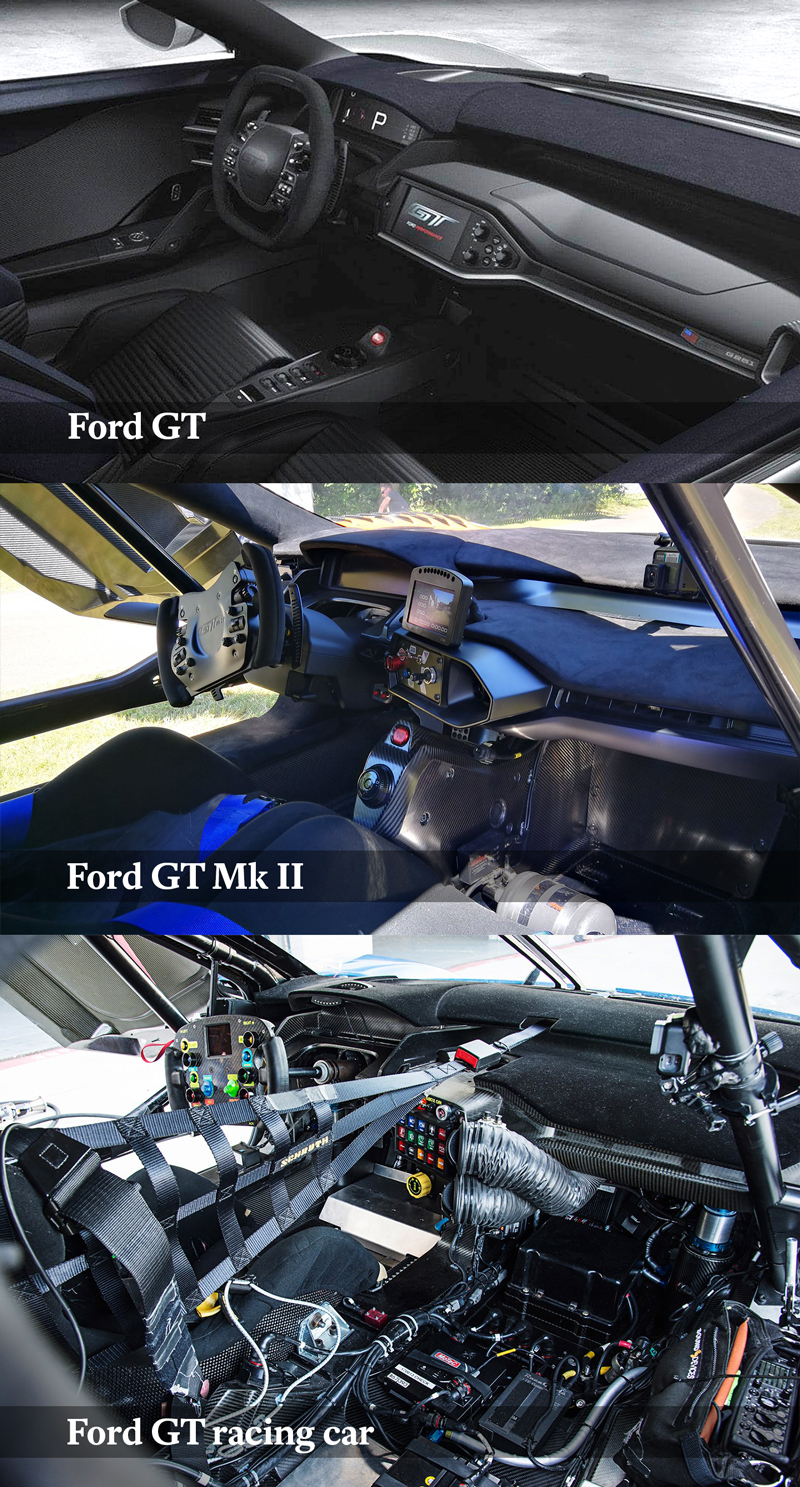
The centre console, which in the road car runs down along the narrow gap between the seats, is completely revised to accommodate the wider seats, and in fact the whole central stack is new in the Mk II. Where the road car’s central touchscreen would be is a panel of switches —for things as mundane as adjusting the mirrors to killing the engine and electrics in the event of an accident. The race-like layout is crude but designed to allow drivers to find the crucial switches quickly and easily, even if the cabin was filling with smoke.
There is a screen above that — a customised Motec C185 unit — which performs several vital functions, not least the view from the rear camera (rear visibility is not great in any GT, as you can imagine). Temperatures and speed are also displayed here, leaving the main driver display mainly for a clear view of revs and current gear.
What it feels like to ride in the Ford GT Mk II
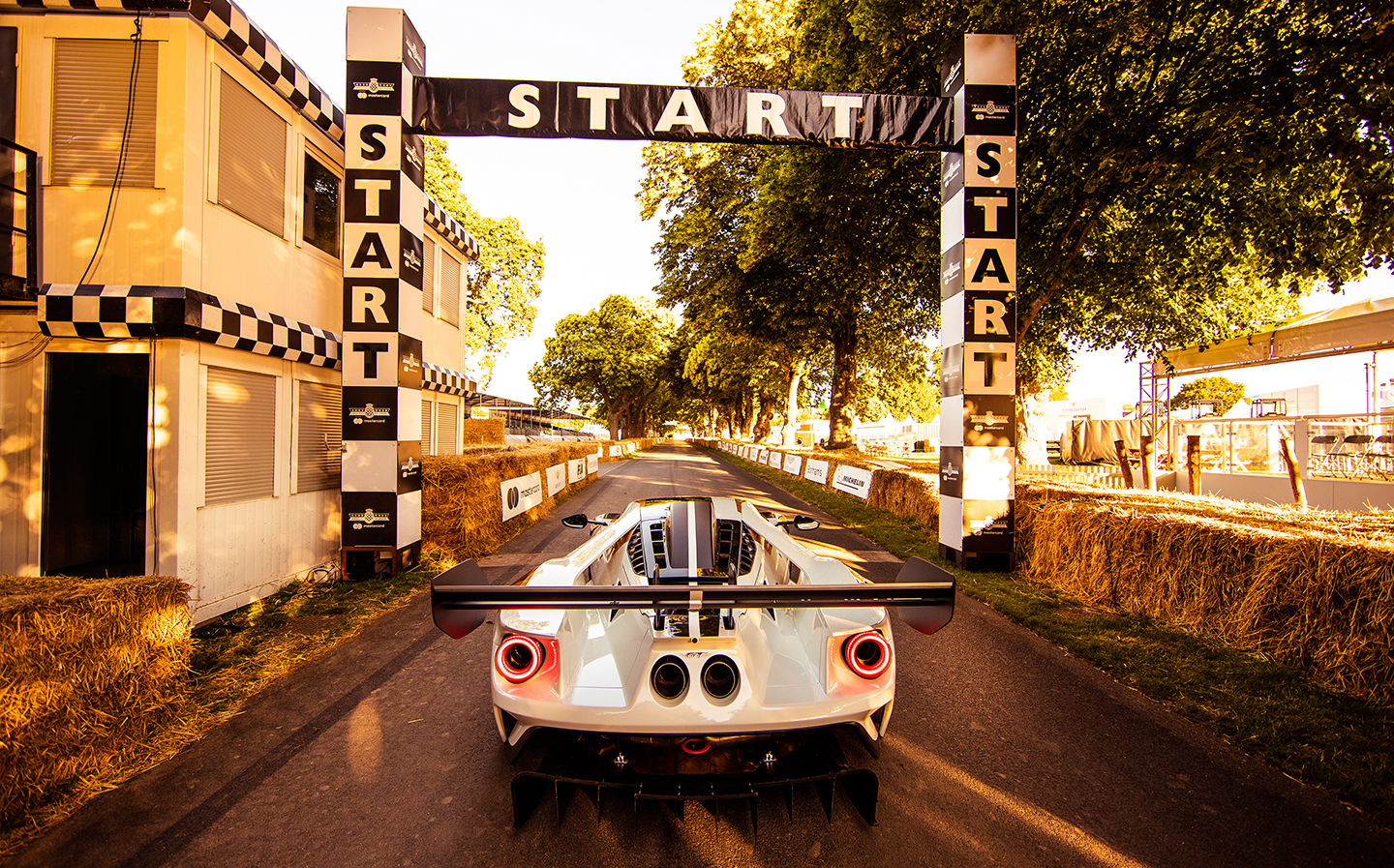
Eventually I got a tap on the shoulder from Maxwell and he instructed me to clamber back in. I steeled myself for the sauna, pulled myself aboard and strapped in. The engine was fired up — it makes a deep, throaty purr at tickover, rather than a wild scream or shuddering rumble — and we made our way to the start line.
I wasn’t sure what to expect from the ride but imagined Maxwell wouldn’t be hitting ten tenths with me in the car. Just as we took our position next to the flag man, he shouted through his helmet, “This is only my second run ever here, after this morning’s demo, so bear with me as I’m still learning the track.”
Was this meant as a comfort? Did it mean he’d be taking it easy or that it’s possible we might end up on the grass — or in the straw bales — as he explored the limits? Either way, I resolved not to chat to him during the run for fear I might distract him from the task at hand, and I prayed he’d at least remembered the tricky Molecomb left-hander, which has caught out many a professional driver in the past.
I’d barely finished the thought when the flagged dropped and we were away. It was a steady but undoubtedly quick launch, with just a hint of wheelspin and an almighty shove in my back. We shot toward the first corner with each gearchange providing a momentary jolt before the forward thrust resumed. Then hard on the brakes into the first right-hander, another blast of throttle and then brakes again into the second right.
The Goodwood Hill is famously bumpy but the GT MK II didn’t seem to become too unsettled as Maxwell floored it past Goodwood House and under the bridge, bar a few minor corrections to the steering.
We were moving at a pace beyond that of a regular driver but it became clear that Maxwell was being relatively cautious as he felt his way into Molecomb, somewhat to my relief. He had done his homework.
Similarly, there was no drama as we swept right and left past the famous flint wall, then fired through the next few kinks up to the finish line. The whole thing, which you can watch below, lasted little over a minute.
“I was too hesitant into the left-hander back there,” Maxwell admitted while scrubbing off speed before the assembly area, as if looking for feedback. I reassured him that I’d rather he was too slow than too fast through Molecomb, and reflected that it’s much more unsighted on the approach than you imagine from watching on the big screens. “Well, I’ll be quicker next time, and maybe by my last run on Sunday I’ll have nailed it,” he joked.
The Goodwood Hill is a special place to drive any car but in a performance machine like the Ford GT Mk II, it’s frustratingly Mickey Mouse. To exploit the full potential and get the most out of it, you need a dedicated track and free reign to complete lap after lap. Now that’s an invite we’d be delighted to receive, especially if it involved time behind the wheel. Your move, Ford.
https://www.driving.co.uk/news/20-years-of-clarkson-ford-gt-review-2005/



